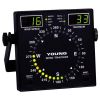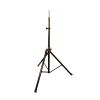YOUNG AQ Wind Monitors
Features
- Wind speed 0-50 m/s (112 mph)
- Meets US EPA Ambient Monitoring Guidelines for Prevention of Significant Deterioration (PSD)
- Precision grade, stainless steel ball bearings are used throughout
- Free ground shipping
- Expedited repair and warranty service
- Lifetime technical support
- More
Overview
The YOUNG 05305 AQ Wind Monitor is a high-resolution wind sensor designed specifically for air quality applications. Available with two additional output signal options. Model 05305V offers calibrated 0 -1 VDC outputs (0-5 VDC optional), convenient for use with many data loggers. Model 05305L provides a calibrated 4-20 mA current signal for each channel, useful in high noise areas or for long cables (up to several kilometers). Signal conditioning electronics are integrated into the sensor junction box.
Mechanics
Wind speed is sensed by a lightweight, carbon fiber thermoplastic (CFT), helicoid propeller. Propeller rotation produces an AC sine wave voltage signal with a frequency directly proportional to wind speed. Slip rings and brushes are not used.
The wind direction sensor is a lightweight vane with performance characteristics that assure excellent fidelity in fluctuating wind conditions. Vane position is sensed by a precision potentiometer. Output is a DC voltage directly proportional to the vane angle.
Design
The instrument body is UV stabilized plastic with stainless steel and anodized aluminum fittings. Precision-grade, stainless steel ball bearings are used throughout. Transient protection and cable terminations are located in a convenient junction box. The instrument mounts on a standard 1" pipe.
Applications
The RM Young 05305 AQ Wind Monitor meets the requirements of the following regulatory agencies: the U.S. Environmental Protection Agency's Ambient Monitoring Guidelines for Prevention of Significant Deterioration (PSD), the U.S. Nuclear Regulatory Agency's NRC Regulatory Guide 1.23 Meteorological Programs in Support of Nuclear Power Plants, and the American Nuclear Society's Standard for Determining Meteorological Information at Power Plants.
In The News
Village Green Project builds air quality awareness with monitoring park bench
The U.S. Environmental Protection Agency is on a mission to make air quality monitoring cheaper, easier and more accessible through the implementation of innovative new monitoring stations. The Village Green Project is a new initiative from the EPA that seeks to increase the scope of air quality monitoring by seamlessly incorporating monitoring devices into community settings. Led by Gayle Hagler, an environmental engineer at the EPA Office of Research and Development, an EPA design team has constructed a prototype that combines the ability to monitor ozone and fine particulate matter as well as wind speed, wind direction, temperature and humidity all into the functional design of a park bench.
Read MoreNASA develops ocean surface wind speed measurements through GPS
Researchers from the NASA Langley Research Center in Hampton, Va., have discovered that GPS signals can be used to accurately measure wind speed at the ocean’s surface, National Geographic has reported. Researchers have concluded that by measuring the distortion in GPS signals bouncing off the ocean’s waves, they can successfully measure wind speed, even in the case of hurricanes and extreme weather. To measure the accuracy of using GPS for wind measurements, NASA scientists placed GPS receivers on NOAA research planes. They concluded that GPS data has an accuracy capable of detecting wind speeds within 11 miles per hour.
Read MoreUNC's industry-standard water quality profiling platforms get upgrade
The University of North Carolina Institute Of Marine Sciences has a history with profiling platforms. UNC engineers and scientists have been building the research floaters for 10 years in a lab run by in Rick Luettich, director of the institute. UNC scientists and engineers developed their own autonomous vertical profilers to take water quality readings throughout the water column. They have three profilers placed in the New and Neuse rivers. The profilers are designed to drop a payload of sensors to an allotted depth at set time intervals. Instruments attached take readings continuously on the way down and up. Data collected by the profilers has been used to study water related issues such as infectious disease and sediment suspension.
Read More














